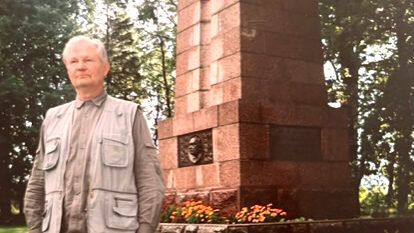Targeted sources can be: domestic security personnel, diplomats/military attachés, couriers, cutouts (usually principal agents acting as buffers between case officers and foreign agents), non-governmental organizations (NGO's), refugees, prisoners, etc.
It is crucial in ‘humint' to rigorously rate the credibility and reliability of human sources and the accuracy of the information they provide. (A vast amount of information that intelligence agencies regularly collect and analyze is openly available – in the media, libraries, government publications, accessible archives, the internet, face book etc.)
When the Russians spotted and recruited Herman Simm, they did not yet know the extent and value of the information he would ultimately provide them. In a classified 141-page report NATO recognized Simm as the spy who had been “the most damaging in Alliance history”. The report states that Simm, as the former head of security at the Estonian Defence Ministry, had access to most of the classified documents NATO shared with his country after being accepted as a full member in 2004. Up to his arrest in 2008, he is suspected of passing on thousands of classified documents to the Russians, some of which contained the most sensitive information of NATO's defence policies, including details regarding cryptographic systems.
Undoubtedly the most damaging result of Simm's activities was the negative reinforcement of latent distrust of the former Soviet Bloc newcomers that still lingered within the military of the older NATO member states. One could logically doubt the genuine loyalty that former Soviet trained officers and their Warsaw Pact comrades of the Cold War era professed to have towards the Atlantic Alliance, their previous enemy. The exposure of Simm reaffirmed the NATO skeptics' uneasiness with their new brothers-in-arms. This does not detract from the bona fide commitment that formerly Soviet/Communist-trained military personnel may have towards the defense of Western values, the concept of a free and democratic society. Certainly first-hand experience of a totalitarian system, especially one governed by a repressive foreign power, should give an extra incentive not to submit to the cajoling, coercion or black-mail of a Russian recruiter. That recruiter represents a government that professes to be the legal successor
It's said that Simm was honoured with a Russian military decoration for, amongst other things, providing the SVR (Russia's foreign intelligence service) with the identities of all Russians working as spies for NATO. Ironically in February of 2006, Simm received the “Order of the White Star” from the Estonian president for his “service to the Estonian nation”.
When was he recruited? One can trace his first cooperation with Soviet special services back to 1966, when Simm, as a student witnessed a brawl between police and a gang of youths. He joined the fray on the side of the police and with his help the police overpowered the gang. The authorities were impressed that a student would come to their assistance and offered him a job. That supposedly was the beginning of his assignments for the KGB, something that he kept a tight secret. Simm in this instance probably saw his recruitment as a reward for his help. Often however, the KGB's recruitment process uses a negative incentive such as the threat of prosecution of the recruit for criminal activity or exposure of previous co-operation with the KGB itself.
His formal career with the police progressed with an honours graduation from the Soviet Union's Interior Ministry Academy in 1975. He also complied with the necessary career advancement requirement by joining the Communist Party. By 1991 Simm had accumulated a total of 44 medals as recognition of his exemplary service and behavior and held the rank of colonel. At the same time the KGB, in leaving its local Tallinn headquarters severed all official ties with him.
Even before Estonia's re-establishment of its independence in 1991, Simm claimed to have come to the rescue of the parliament and government during an attack against the Toompea castle by pro-Moscow Russians in 1990. He was treated as a hero and this image boosted his rapid progress within the Estonian police until he was director of country's national police service in 1994. This lasted for only six months before he was dismissed for corruption.
Simm has stated that as a result of a break up with a girlfriend in 1995 he went on a visit to Tunisia. There, he claims, he was approached by an old KGB colleague ‘Valentin'. According to NATO reports Valery Zentsov, had officially retired to Russia in 1991 from his KGB job in Tallinn. But in reality he was actually involved with developing a network of agents in the Baltic states.
NATO investigators believe it's a possibility that Simm never ceased to be an agent, staying in Estonia as a ‘sleeper', biding his time until he was duly reactivated. Simm on the other hand insists that he balked at Zentov's recruitment attempts. However, he said, since he had been fired with no good outlook for the future and with Zentzov threatening to expose Simm's KGB past, Simm finally relented, insisting he be ranked as a colonel.
Simm also has stressed that he agreed to co-operate only if nothing he did would harm Estonia's national interests. Zentsov, Simm stated, reassured him that Russia's only apprehension was the possibility of NATO establishing bases in Estonia as forward positions for an attack against Russia.
In explaining his willingness to be recruited Simm explained that the Russians had found him in Tunisia and consequently were capable of finding him anywhere. This statement might have had credibility if one were to accept Simm' story about the trip being a form of consolation after a break-up with a girlfriend. But one can easily assume that the trip was mutually arranged so that a contact could be made in a distant location without fear of intruding eyes.
It's more likely that Simm was swayed by Zentsov's offer of 1,000 euros a month plus expensess during a period when Simm suffered financially. Probably more important as a coercion/intimidation tool was Zentsov's blatant threat to expose Simm's earlier affiliation with the KGB. (To be continued.)
Laas Leivat




